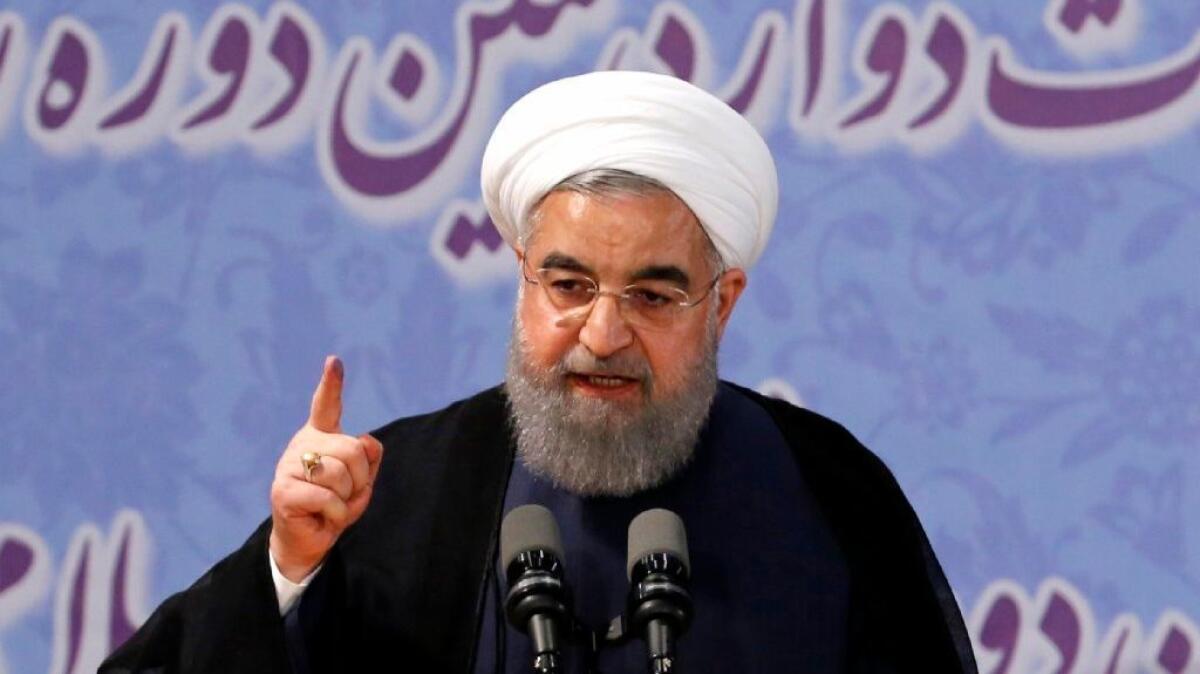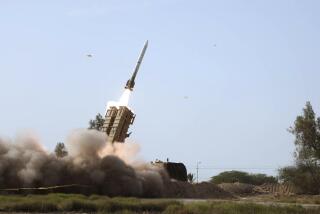The Iran nuclear deal that Trump once vowed to tear apart is holding — at least for now

- Share via
Reporting from WASHINGTON — A skeptical Trump administration has confirmed that Iran continues to comply with the 2015 nuclear disarmament deal but says the White House is conducting an internal review of the landmark arms control accord that President Trump once called “the worst deal ever.”
Secretary of State Rex Tillerson said in a letter to Congress that the National Security Council will lead an interagency review of whether easing economic sanctions against Iran as part of the accord “is vital to the national security interests of the United States.”
“Iran remains a leading state sponsor of terror through many platforms and methods,” Tillerson wrote.
The Treasury Department still maintains Obama-era sanctions aimed at Tehran’s support for terrorist groups and its ballistic missile program, and those conceivably could be tweaked. But any moves to impose a major new regime of penalties could undermine the accord and spur a new nuclear crisis in the Middle East.
The review also could recommend more subtle ways to apply pressure to Tehran, which actively supports militant groups such as Lebanon-based Hezbollah and Hamas in the Gaza Strip, as well as Houthi fighters in Yemen and President Bashar Assad’s military in Syria, all of which the U.S. opposes.
It comes as the White House has scrambled to balance the threat of direct military action and the pursuit of diplomatic options, especially with China, to slow or block North Korea from expanding its nuclear arsenal and developing an intercontinental ballistic missile that could deliver a warhead to U.S. shores.
Tensions rose sharply in northeast Asia last week when the Trump administration and North Korean leader Kim Jong Un’s government traded bellicose threats about a possible clash over an expected North Korean nuclear test.
In the end, Pyongyang test-fired a midrange ballistic missile that fell into the sea seconds after launch, defusing the crisis for now. And White House warnings that an aircraft carrier strike force was rushing north proved false; the armada was 3,500 miles away last weekend although the Pentagon insisted Wednesday that the Carl Vinson and three other warships are now en route to the Sea of Japan.
As a candidate, Trump vowed to “rip up” the nuclear deal with Iran as soon as he took office, one of several signature campaign promises on foreign policy that he has ignored.
Several members of Trump’s incoming Cabinet said during their Senate confirmation hearings that they had decided the accord had effectively constrained Iran’s ability to produce a nuclear bomb, and Trump has not moved to abrogate the accord.
Trump similarly has not moved to “cancel” the Paris climate accord of 2015, despite his vow on the campaign trail, nor has he abandoned the “one China” policy that has guided U.S. relations with Beijing for 40 years or reversed the Obama administration’s opening to Cuba, although a high-level review of Cuba policy is underway.
Congress has required the State Department to notify it every 90 days whether Iran is in compliance with the nuclear deal, which required Tehran to dismantle or disable its nuclear infrastructure, including its ability to produce bomb-grade fuel.
This was the first notification under the Trump administration.
The United Nations Security Council lifted a web of trade, banking and other sanctions on Iran last year after the International Atomic Energy Agency, the U.N.’s nuclear watchdog agency, certified Tehran’s compliance with the nuclear deal.
The IAEA continues to monitor Iran’s facilities through regular visits, cameras and other surveillance systems. Iran’s leaders have always insisted they did not seek to build a bomb.
In January, a year after the deal came into force, the IAEA said that Iran had reduced its uranium stockpile by 98% and had removed two-thirds of its centrifuges, which can be used to enrich uranium.
Critics long have complained that the accord, officially called the Joint Comprehensive Plan of Action, did not address Iran’s support for terrorist groups. It focused only on curbing Tehran’s ability to someday produce a nuclear bomb, which was seen as the primary threat to global security.
Since taking office, administration officials have realized that pulling out of the deal would be more complicated than Trump had suggested at his campaign rallies.
Since it was negotiated with Iran by six world powers — the United States, Britain, France, China, Russia and Germany — a unilateral U.S. withdrawal would create diplomatic chaos, especially if Washington were to impose new sanctions over the objections of the other signatories.
Moreover, numerous security experts have warned that abandoning the deal could give Iran an excuse to eject the IAEA inspectors, rebuild its infrastructure, resume uranium enrichment and take other steps toward building a bomb — but deprive Washington of the diplomatic leverage and on-the-ground intelligence gathering needed to punish Tehran.
Even Israel, one of the most vocal opponents of the accord when it was being negotiated, has told the Trump administration that it should focus on finding additional measures to crack down on Iranian-backed terrorism, not linger on voiding the existing accord, diplomatic sources said.
White House Press Secretary Sean Spicer, asked about the Iran certification Wednesday, said Trump would await the review before deciding on the next step.
“That’s why we’re undergoing this interagency review,” Spicer said at a news briefing. “We will have recommendations that will be presented to the president on where the deal stands and how to act further.”
For now, the administration took steps to shore up its alliance with Saudi Arabia, Iran’s chief rival in the region. Iran is a Shiite Muslim theocracy whereas the Saudi kingdom is Sunni dominated.
Relations with Riyadh had deteriorated under the Obama administration, which criticized Saudi airstrikes on civilian targets in neighboring Yemen in that country’s civil war.
On a visit to Riyadh on Wednesday, Defense Secretary James N. Mattis told Saudi officials that it was important to “reinforce Saudi Arabia’s resistance to Iran’s mischief.”
Speaking later to reporters, Mattis added, “Everywhere you look [that] there’s trouble in the region, you find Iran.” He said the Trump administration would help countries “trying to checkmate” Iran.
Critics of the nuclear accord with Iran applauded the interagency review as a way to increase pressure on Tehran.
“It underscores the Trump administration’s commitment to ramp up pressure on Iran through the use of sanctions tied to terrorism and other malign activities,” said Mark Dubowitz, head of the Washington-based Foundation for Defense of Democracies, a think tank that opposed the Iran accord.
Tillerson made the same point later Wednesday at the State Department, saying the White House will look at more than whether Iran is meeting its obligations under the nuclear accord, citing its human rights record, its support for militants and what he called its “alarming and ongoing provocations to export terror and violence.”
The Iran nuclear deal, he told reporters, is “another example of buying off” an adversary that “only delays” production of nuclear weapons, citing a series of failed diplomatic deals with North Korea since the mid-1990s.
“A comprehensive Iran policy requires we address all of the threats posed by Iran and it’s clear there are many,” he said.
Bold promises, fewer results: Trump’s executive orders don’t always live up to his claims »
Times staff writer W.J. Hennigan in Washington contributed to this report.
For more on international affairs, follow @TracyKWilkinson on Twitter
More to Read
Sign up for Essential California
The most important California stories and recommendations in your inbox every morning.
You may occasionally receive promotional content from the Los Angeles Times.











